Microwave Sintering Rapid Synthesis of Nano/Micron β-SiC from Waste Lithium Battery Graphite and Photovoltaic Silicon to Achieve Carbon Reduction
Abstract
:1. Introduction
2. Materials and Methods
3. Results
4. Conclusions
Author Contributions
Funding
Acknowledgments
Conflicts of Interest
References
- International Renewable Energy Agency (IRENA). Renewable Power Generation Costs in 2019. 2020. Available online: https://www.irena.org/publications/2020/Jun/Renewable-Power-Costs-in-2019 (accessed on 20 April 2021).
- Silva, M.D.F.M.E.; Calijuri, M.L.; de Sales, F.J.F.; de Souza, M.H.B.; Lopes, L.S. Integration of technologies and alternative sources of water and energy to promote the sustainability of urban landscapes. Resour. Conserv. Recycl. 2014, 91, 71–81. [Google Scholar] [CrossRef]
- Yan, J.; Yang, Y.; Campana, P.E.; He, J. City-level analysis of subsidy-free solar photovoltaic electricity price, profits, and grid parity in China. Nat. Energy 2019, 4, 709–717. [Google Scholar] [CrossRef]
- Zhang, Q.; Fu, L. Research on photovoltaic modules waste prediction in China. Environ. Eng. 2020, 38, 214–220. [Google Scholar]
- Chowdhury, M.S.; Rahman, K.S.; Chowdhury, T.; Nuthammachot, N.; Techato, K.; Akhtaruzzaman, M.; Tiong, S.K.; Sopia, K.; Amin, N. An overview of solar photovoltaic panels’ end-of-life material recycling. Energy Strateg. Rev. 2020, 27, 100431. [Google Scholar] [CrossRef]
- Widmer, R.; Oswald-Krapf, H.; Sinha-Khetriwal, D.; Schnellmann, M.; Böni, H. Global perspectives on e-waste. Environ. Impact Assess. Rev. 2005, 25, 436–458. [Google Scholar] [CrossRef]
- Zimmermann, Y.S.; Niewersch, C.; Lenz, M.; Kul, Z.Z.; Corvini, P.F.X.; Schaffer, A.; Wintgens, T. Recycling of Indium from CIGS Photovoltaic Cells: Potential of Combining Acid-Resistant Nanofiltration with Liquid-Liquid Extraction. Environ. Sci. Technol. 2014, 48, 13412–13418. [Google Scholar] [CrossRef]
- Zeng, C.; Ramos-Ruiz, A.; Field, J.A.; Sierra-Alvarez, R. Cadmium telluride (CdTe) and cadmium selenide (CdSe) leaching behavior and surface chemistry in response to pH and O2. J. Environ. Manag. 2015, 154, 78–85. [Google Scholar] [CrossRef]
- Dias, P.; Javimczik, S.; Benevit, M.; Veit, H.; Bernardes, A.M. Recycling WEEE: Extraction and concentration of silver from waste crystalline silicon photovoltaic modules. Waste Manag. 2016, 57, 220–225. [Google Scholar] [CrossRef] [PubMed]
- Lee, J.S.; Ahn, Y.S.; Kang, G.H.; Wang, J.P. Recovery of Pb-Sn Alloy and Copper from Photovoltaic Ribbon in Spent Solar Module. Appl. Surf. Sci. 2017, 415, 137–142. [Google Scholar] [CrossRef]
- Yousef, S.; Tatariants, M.; Denafas, J.; Makarevicius, V.; Lukosiute, S.I.; Kruopiene, J. Sustainable industrial technology for recovery of Al nanocrystals, Si micro particles and Ag from solar cell wafer production waste. Sol. Energy Mater. Sol. Cells 2019, 191, 493–501. [Google Scholar] [CrossRef]
- Ardente, F.; Latunussa, C.E.L.; Blengini, G.A. Resource efficient recovery of critical and precious metals from waste silicon PV panel recycling. Waste Manag. 2019, 91, 156–167. [Google Scholar] [CrossRef]
- Tan, Q.; Duan, H.; Liu, L.; Yang, J.; Li, J. Rethinking residential consumers’ behavior in discarding obsolete mobile phones in China. J. Clean. Prod. 2018, 195, 1228–1236. [Google Scholar] [CrossRef]
- Guo, X.; Yan, K. Estimation of obsolete cellular phones generation: A case study of China. Sci. Total Environ. 2017, 575, 321–329. [Google Scholar] [CrossRef]
- Träger, T.; Friedrich, B.; Weyhe, R. Recovery concept of value metals from automotive lithium-ion batteries. Chem. Ing. Tech. 2015, 87, 1550–1557. [Google Scholar] [CrossRef]
- Liu, K.; Yang, S.; Lai, F.; Wang, H.; Huang, Y.; Zheng, F.; Wang, S.; Zhang, X.; Li, Q. Innovative Electrochemical Strategy to recovery of cathod and efficient lithium leaching from spent lithium batteries. ACS Appl. Energy Mater. 2020, 3, 4767–4776. [Google Scholar] [CrossRef]
- Wang, M.; Tan, Q.; Chiang, J.F.; Li, J. Recovery of rare and precious metals from urban mines—A review. Front. Environ. Sci. Eng. 2017, 11, 1–17. [Google Scholar] [CrossRef]
- Zeng, X.; Li, J.; Shen, B. Novel approach to recover cobalt and lithium from spent lithium-ion battery using oxalic acid. J. Hazard. Mater. 2015, 295, 112–118. [Google Scholar] [CrossRef] [PubMed]
- Paulino, J.F.; Busnardo, N.G.; Afonso, J.C. Recovery of valuable elements from spent Li-batteries. J. Hazard. Mater. 2008, 150, 843–849. [Google Scholar] [CrossRef] [PubMed]
- Ma, Z.; Cui, Y.; Zuo, X.X.; Sun, Y.H.; Xiao, X.; Nan, J.M. Self-assembly folwer like porous carbon nanosheet powders for higher lithium-ion storage capacity. Electrochim. Acta 2015, 184, 308–315. [Google Scholar] [CrossRef]
- Zheng, X.; Gaol, W.; Zhangl, X.; Hel, M.; Linl, X.; Gaol, H.; Zhangl, Y.; Sun, Z. Spent lithium-ion battery recycling-Reductive ammonia leaching of metals from cathode scrap by sodium sulphite. Waste Manag. 2017, 60, 680–688. [Google Scholar] [CrossRef]
- Xin, Y.; Guo, X.; Chen, S.; Wang, J.; Wu, F.; Xin, B. Xin. Bioleaching of valuable metals Li, Co, Ni and Mn from spent electric vehicle Li-ion batteries for the purpose of recovery. J. Clean. Prod. 2016, 116, 249–258. [Google Scholar] [CrossRef]
- Zhang, Y.; Guo, X.; Wu, F.; Yao, Y.; Yuan, Y.; Luo, X.; Shahbazian-Yassar, R.; Zhang, C.; Amine, K. Mesocarbon microbead carbon-supported magnesium hydroxiede nanoparticles: Turning spent li-ion battery anode into a highly efficient phosphate adsorbent for wastewater treatment. ACS Appl. Mater. Interfaces 2016, 8, 21315–21325. [Google Scholar] [CrossRef]
- Golmohammadzadeh, R.; Faraji, F.; Rashchi, F. Recovery of lithium and cobalt from spent lithium-ion batteries (LIBs) using organic acids as leaching reagents: A review. Resour. Conserv. Recycl. 2018, 136, 418–435. [Google Scholar] [CrossRef]
- Wang, S.L.; Wu, Y.Q.; Lin, L.W.; He, Y.H.; Huang, H. Fracture strain of SiC nanowires and direct evidence of electron-beam induced amorphisation in the strained nanowires. Small 2015, 11, 1672–1676. [Google Scholar] [CrossRef] [PubMed]
- Liu, C.; Yu, D.; Donald, W.K.; Xu, Y. Electromagnetic wave absorption of silicon carbide based materials. RSC Adv. 2017, 7, 595–605. [Google Scholar] [CrossRef] [Green Version]
- Cheng, H.; Yang, M.; Lai, Y.; Hu, M.; Li, O.; Tu, R.; Zhang, S.; Han, M.; Goto, T.; Zhang, L. Transparent highly oriented 3C-SiC bulks by halide laser CVD. J. Eur. Ceram. Soc. 2018, 38, 3057–3063. [Google Scholar] [CrossRef]
- Agarwal, S.; Chen, Q.; Koyanagi, T.; Zhao, Y.; Zinkle, S.J.; Weber, W.J. Revealing irradiation damage along with the entire damage range in ion-irradiated SiC/SiC composites using Raman spectroscopy. J. Nucl. Mater. 2019, 526, 151778. [Google Scholar] [CrossRef]
- Sedov, V.S.; Martyanov, A.K.; Khomich, A.A.; Savin, S.S.; Voronov, V.V.; Khmelnitskiy, R.A.; Bolshakov, A.P.; Ralchenko, V.G. Co-deposition of diamond and β-SiC by microwave plasma CVD in H2 -CH4 -SiH4 gas mixtures. Diam. Relat. Mater. 2019, 98, 107520. [Google Scholar] [CrossRef]
- Qiang, X.; Li, H.; Zhang, Y.; Tian, S.; Wei, J. Synthesis and Raman scattering of SiC nanowires decorated with SiC polycrystalline nanoparticles. Mater. Lett. 2013, 107, 315–317. [Google Scholar] [CrossRef]
- Dasgupta, A.; Klein, S.; Houben, L.; Carius, R.; Finger, F.; Luysberg, M. Microstructure of highly crystalline silicon carbide thin films grown by HWCVD technique. Thin Solid Film. 2008, 516, 618–621. [Google Scholar] [CrossRef]
- Niu, J.; Wang, J. An Approach to the Synthesis of Silicon Carbide Nanowires by Simple Thermal Evaporation of Ferrocene onto Silicon Wafers. Eur. J. Inorg. Chem. 2007, 4006–4010. [Google Scholar]
- Guo, T.; Huang, B.; Li, C.; Lou, Y.; Tang, X.-Z.; Huang, X.; Yue, J. Magnetic sputtering of FeNi/C bilayer film on SiC fibers for effective microwave absorption in the low-frequency region. Ceram. Int. 2021, 47, 5221–5226. [Google Scholar] [CrossRef]
- Sun, J.; Wang, Y.; Wang, W.; Wang, K.; Lu, J. Application of featured microwave-metal discharge for the fabrication of well-graphitized carbon-encapsulated Fe nanoparticles for enhancing microwave absorption efficiency. Fuel 2018, 233, 669–676. [Google Scholar] [CrossRef]
- Wang, J.; Zhang, Y.; Li, J.; Zhang, H.; Song, S.; Zhang, S. Catalytic effect of cobalt on microwave synthesis of β-SiC powder. Powder Technol. 2017, 317, 209–215. [Google Scholar] [CrossRef]
- Yu, S.; Lu, M.; Ji, W.; Nie, Y.; Ji, J. Microwave-assisted catalytic dehydration of glycerol for sustainable production of acrolein over a microwave absorbing catalyst. Appl. Catal. B Environ. 2019, 243, 455–462. [Google Scholar]
- Kuang, J.; Xiao, T.; Zheng, Q.; Xiong, S.; Wang, Q.; Jiang, P.; Liu, W.; Cao, W. Dielectric permittivity and microwave absorption properties of transition metal Ni and Mn doped SiC nanowires—ScienceDirect. Ceram. Int. 2020, 46, 12996–13002. [Google Scholar] [CrossRef]
- Oh, E.; Jung, S.; Lee, J.; Cho, S.; Kim, H.; Lee, B.; Lee, K.; Song, K.; Cho, C.; Han, D. Selective Synthesis of SiC and SiOx Nanowires by Direct Microwave Irradiation. Jpn. J. Appl. Phys. 2011, 50, 025001. [Google Scholar] [CrossRef]
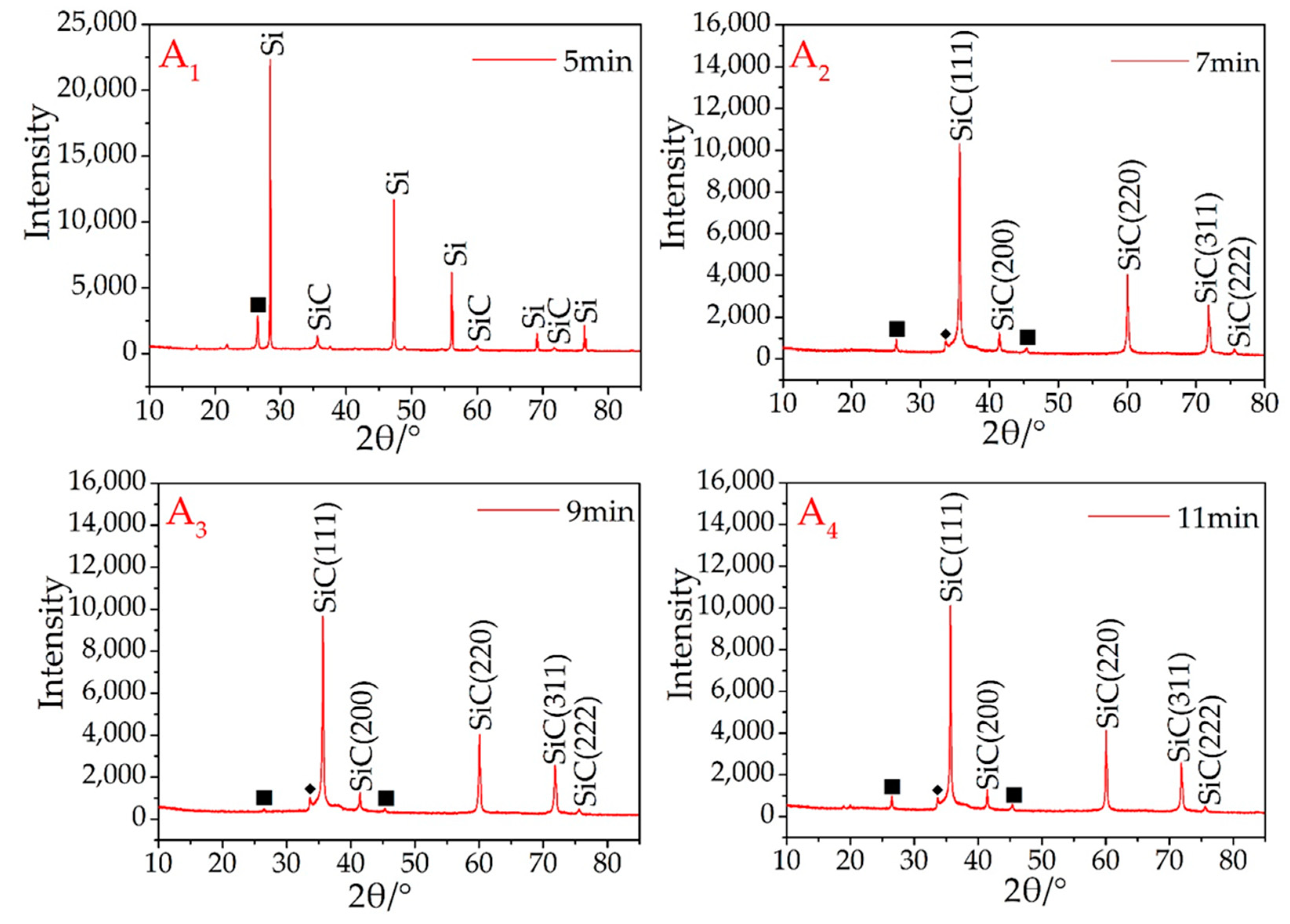

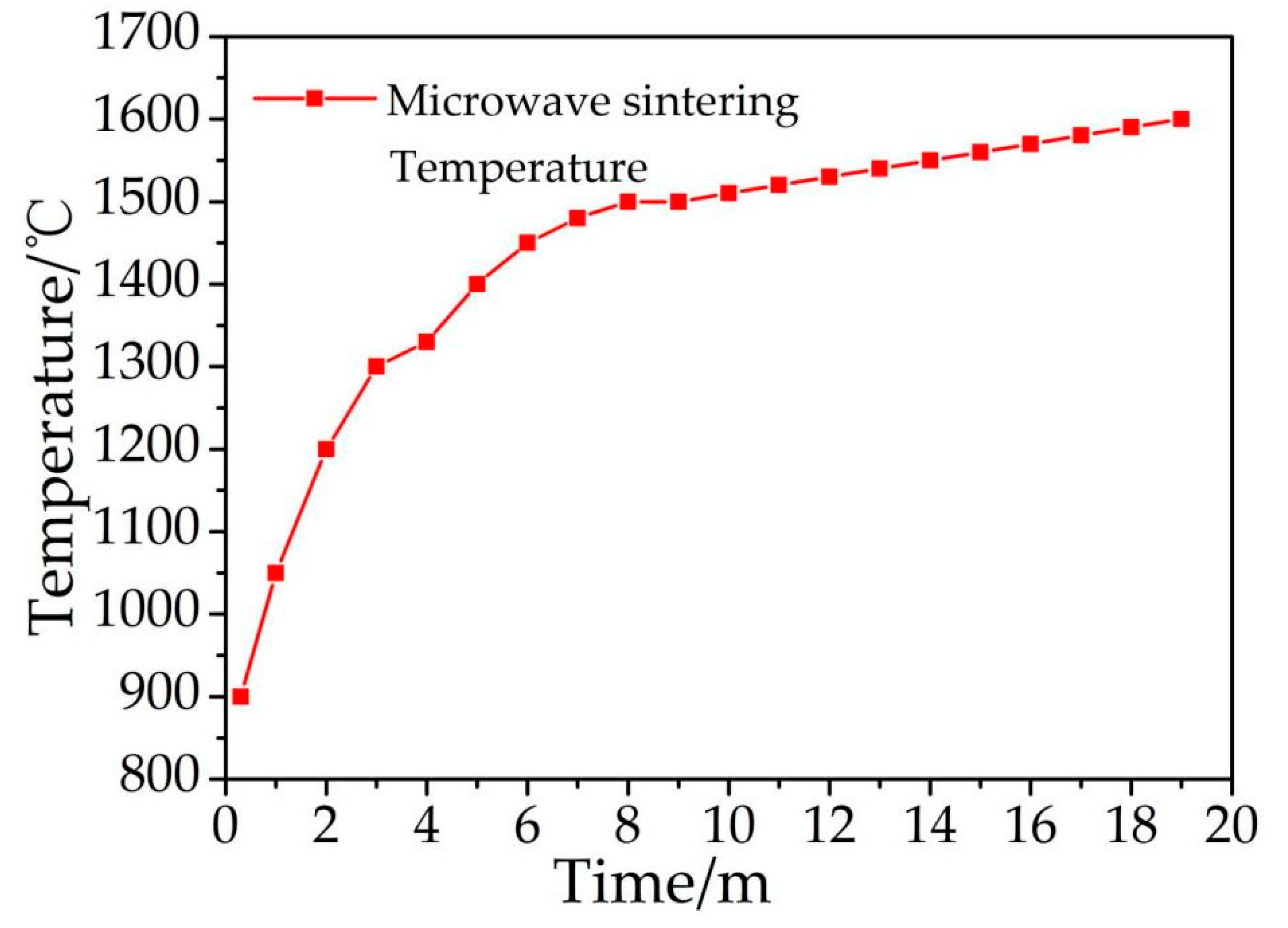
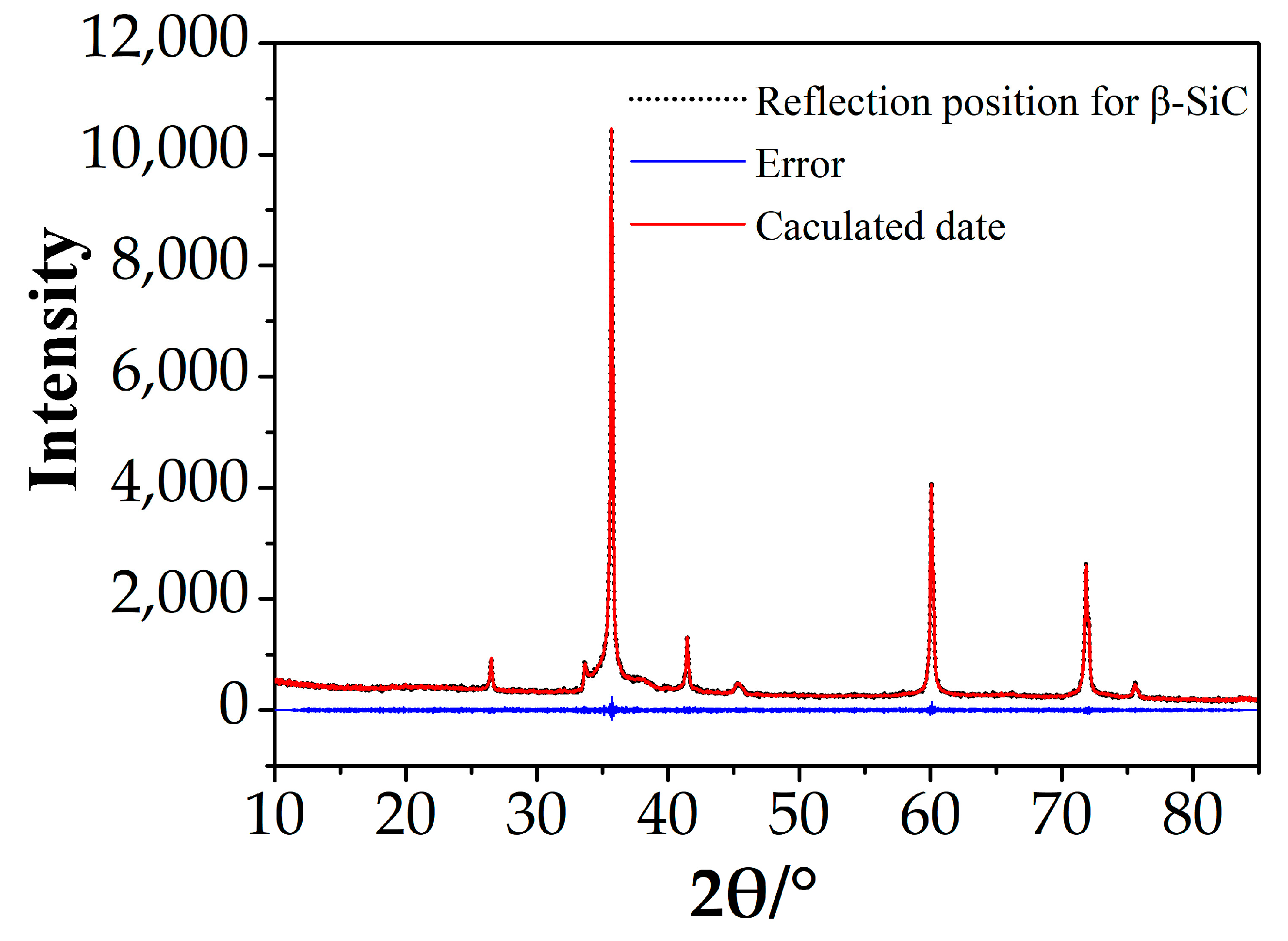
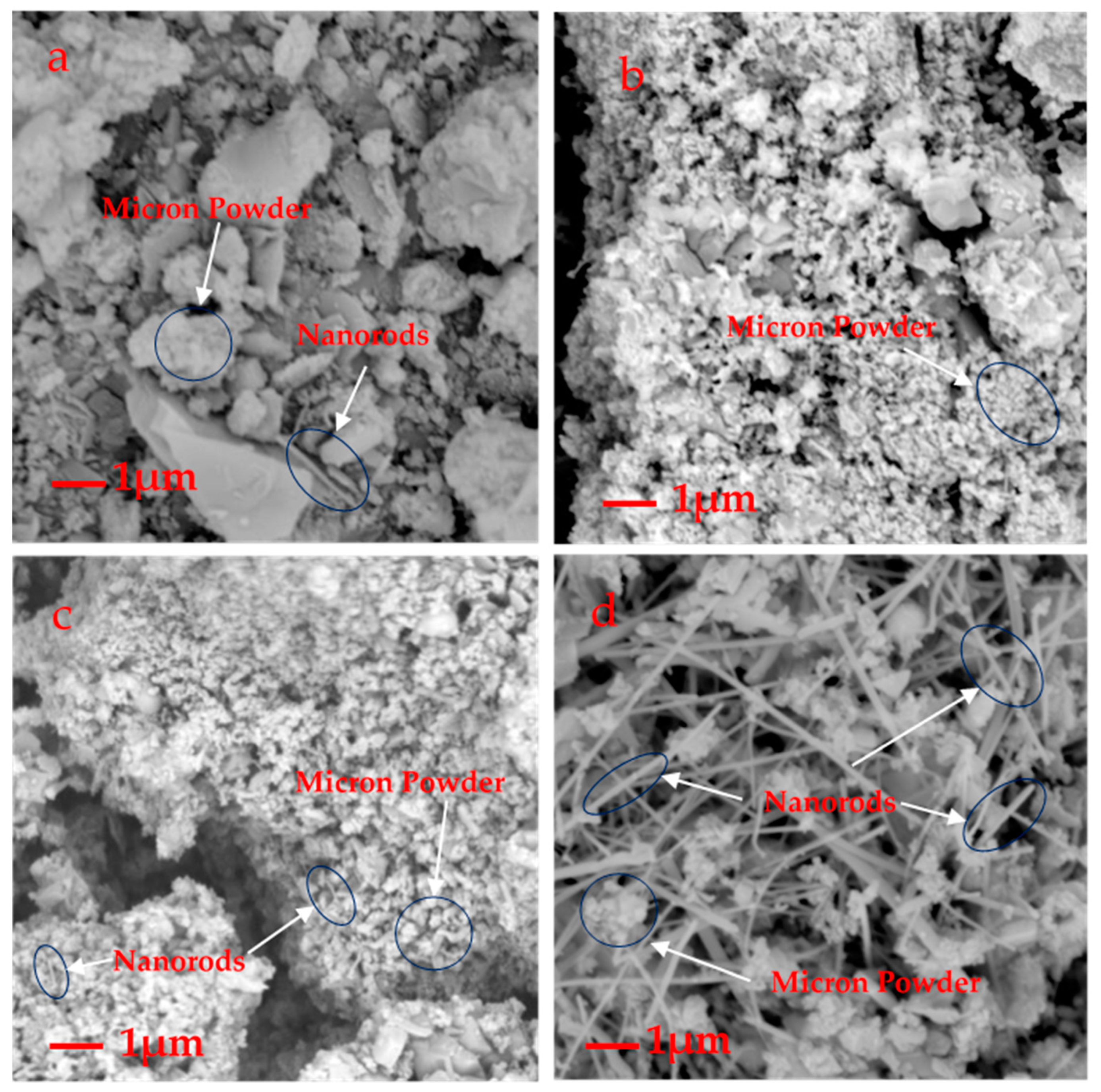
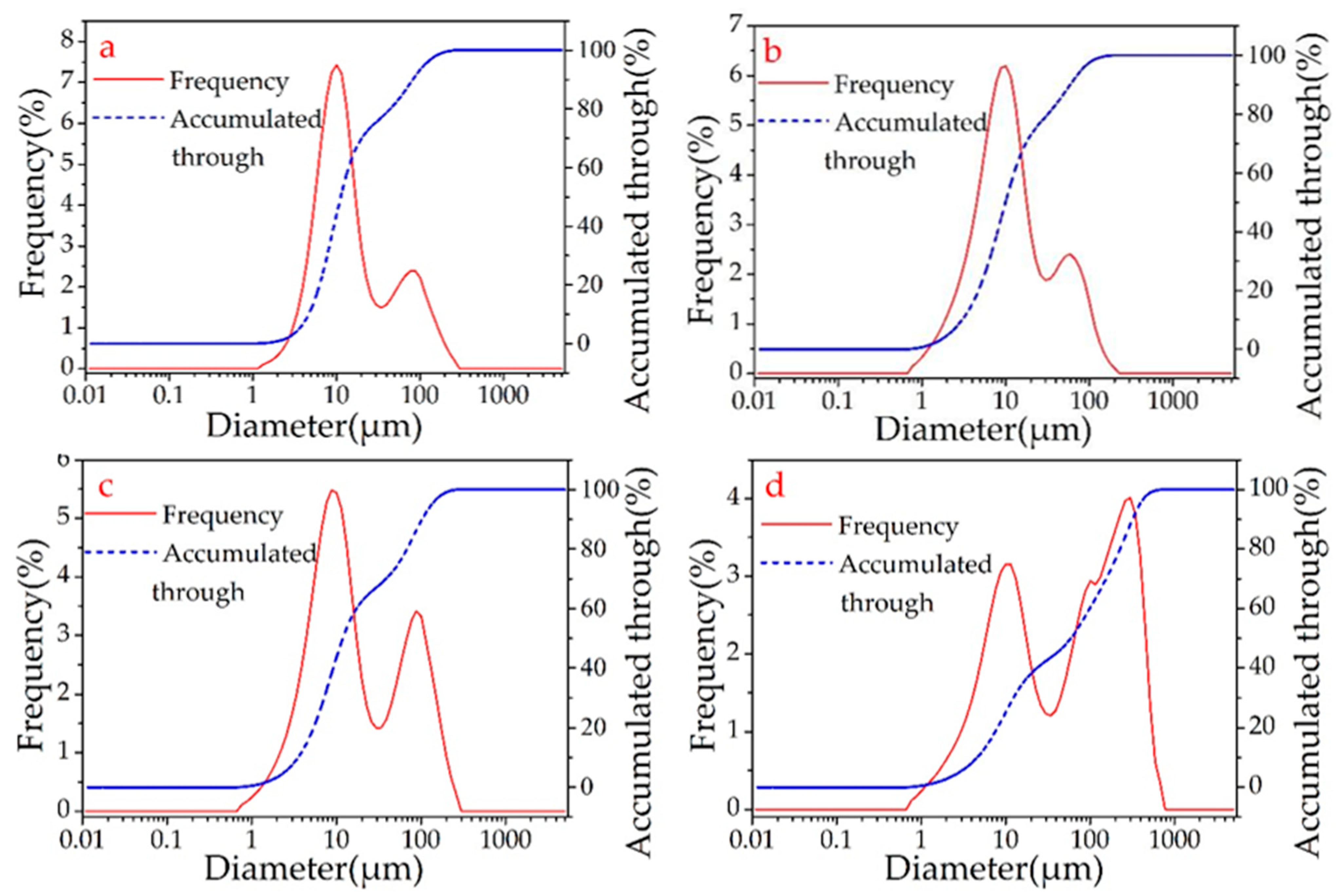
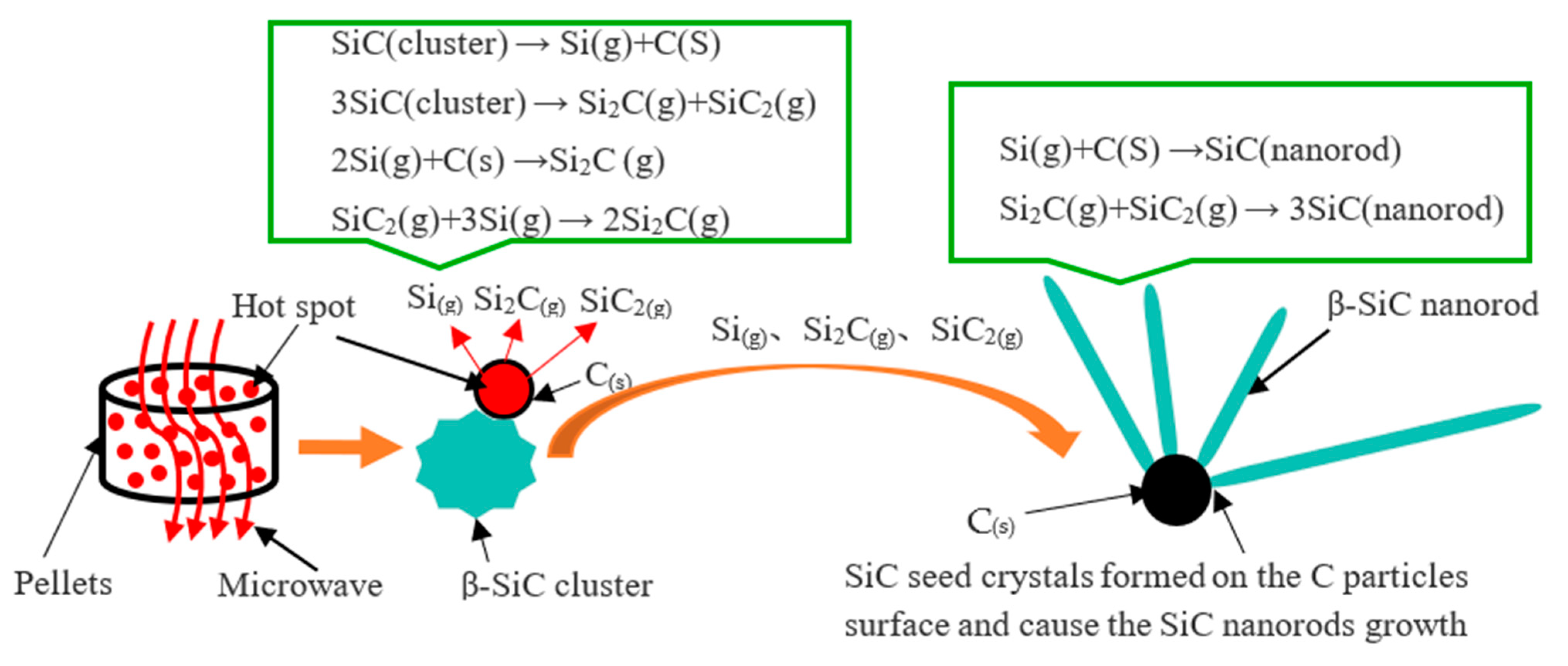

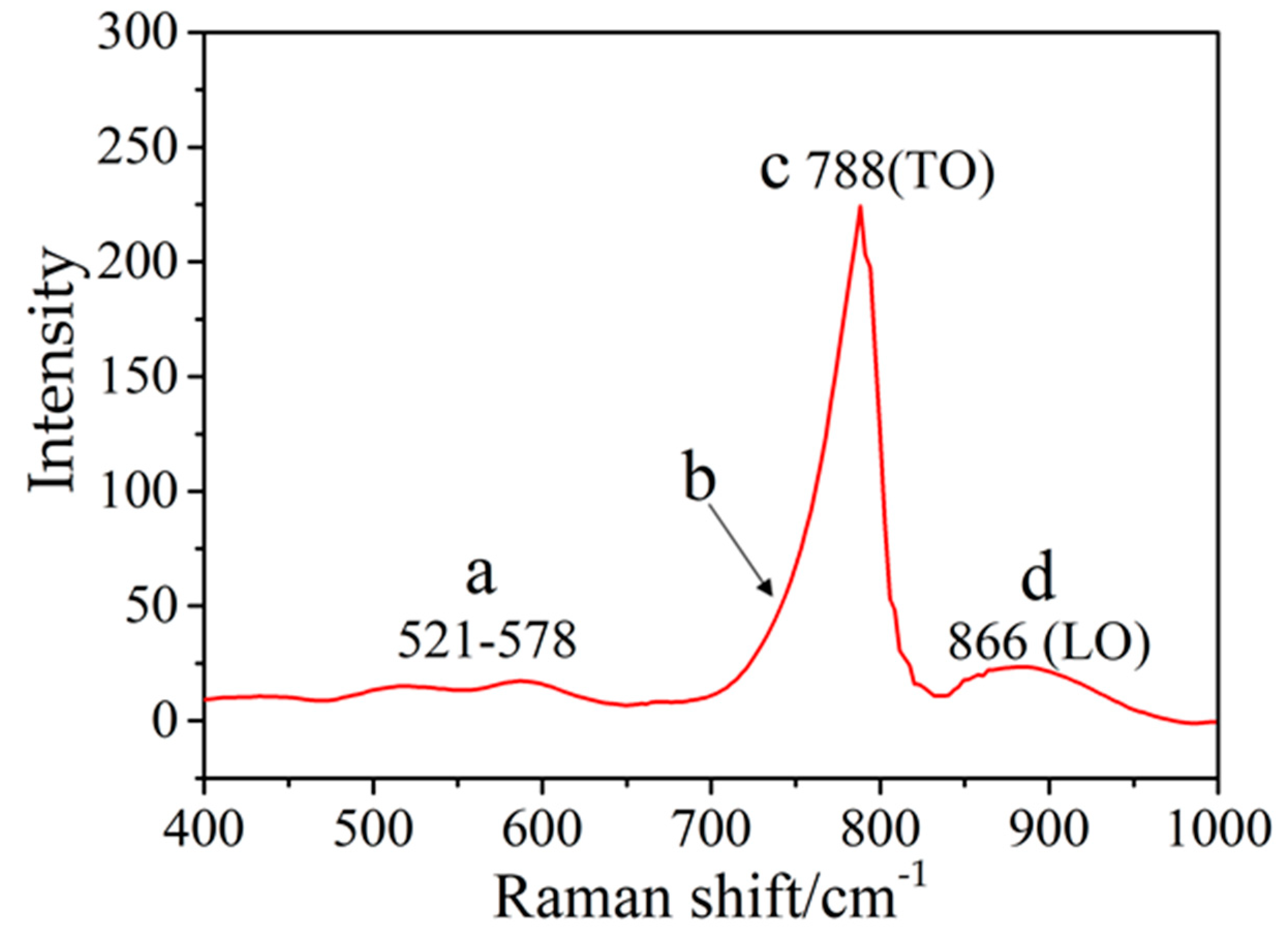
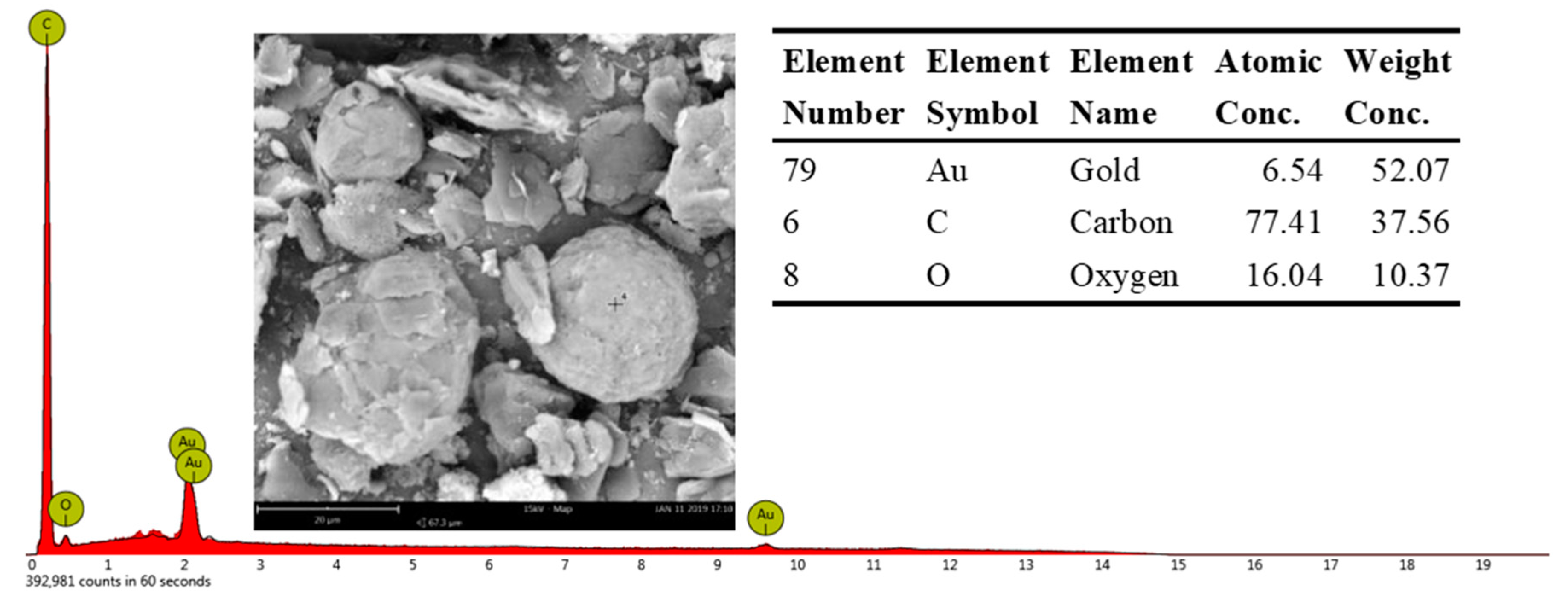
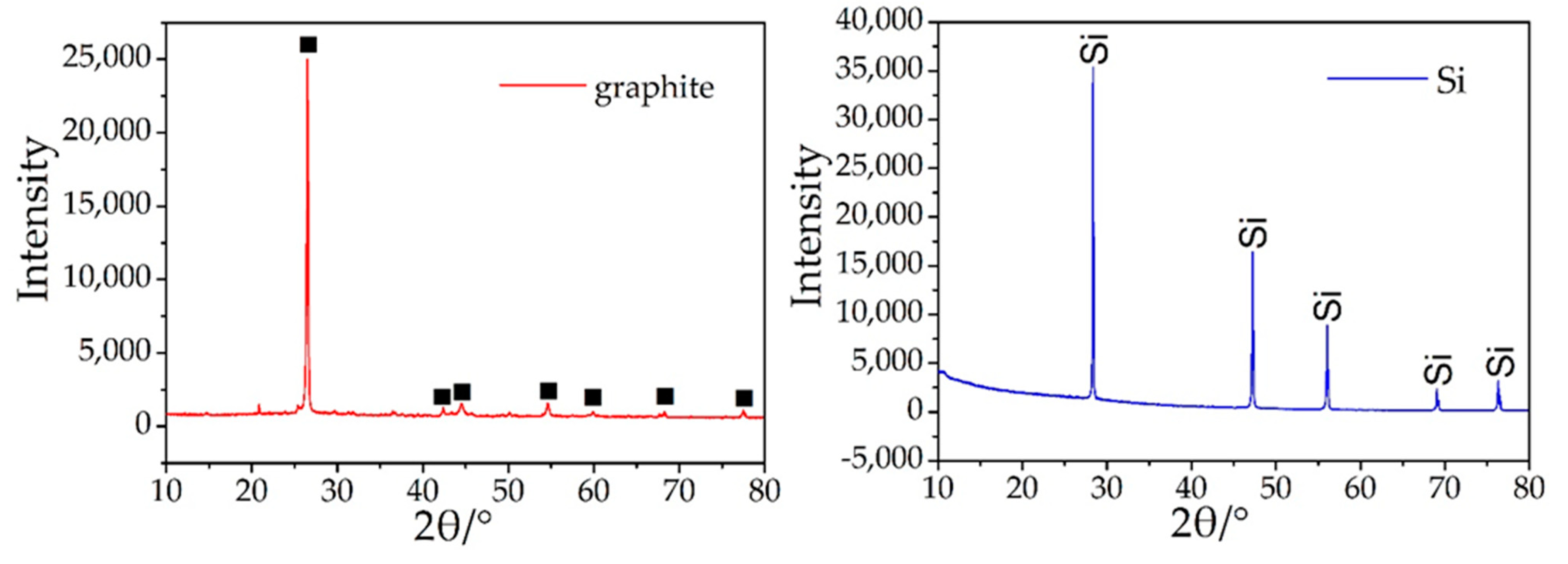
| Sample number | A1 | A2 | A3 | A4 | A5 | A6 | A7 | A8 |
| Sintering time(min) | 5 | 7 | 9 | 11 | 13 | 15 | 17 | 19 |
| Sample | A2 | A5 | A8 |
|---|---|---|---|
| Phases, wt% | β-SiC:97.8%; | β-SiC:98.3%; | β-SiC:97.1%; |
| Z | 4 | 4 | 4 |
| ɑ-Parameter/Å | 4.329 | 4.341 | 4.329 |
| Unit cell vol/Å3 | 81.10 | 81.81 | 81.10 |
| Crystal density, (g/cm−3) | 6.235 | 6.181 | 6.232 |
| Rp | 2.93 | 2.88 | 2.93 |
| Rwp | 3.92 | 3.87 | 3.95 |
| Rexp | 3.88 | 3.79 | 3.88 |
| Sample | A2 | A5 | A6 | A8 |
|---|---|---|---|---|
| D50 (μm) | 11.296 | 9.972 | 11.963 | 59.408 |
| Mean size(μm) | 28.138 | 20.941 | 35.384 | 114.744 |
| Geometric mean size (μm) | 14.789 | 11.373 | 16.065 | 42.578 |
| D10(μm) | 4.680 | 3.032 | 3.528 | 4.608 |
| D90(μm) | 82.590 | 58.987 | 103.243 | 318.899 |
| Metal Name | Fe | Al | Ni | Co | Cu | Mn | K | Li | Cd |
| Content (%) | 0.625 | 0.012 | 0.002 | 0.005 | 0.187 | 0.029 | 1.561 | / | / |
| Metal Name | Zn | Mg | As | Sr | Cr | Ba | Sn | Zr | Na |
| Content (%) | 0.001 | 0.001 | / | / | 0.012 | 0.001 | / | 0.479 | 1.120 |
| Metal Name | Fe | Al | Ni | Co | Cu | Mn | K | Li | Cd |
| Content (%) | 0.100 | 0.831 | 0.266 | 0.572 | 0.255 | 0.084 | 3.815 | 0.097 | / |
| Metal Name | Zn | Mg | As | Sr | Cr | Ba | Sn | Zr | Na |
| Content (%) | 0.006 | 0.010 | 0.007 | 0.003 | 0.017 | 0.010 | 0.001 | 1.73 | 2.101 |
Publisher’s Note: MDPI stays neutral with regard to jurisdictional claims in published maps and institutional affiliations. |
© 2021 by the authors. Licensee MDPI, Basel, Switzerland. This article is an open access article distributed under the terms and conditions of the Creative Commons Attribution (CC BY) license (https://creativecommons.org/licenses/by/4.0/).
Share and Cite
Zhao, M.; Chen, Q.; Johnson, M.; Awasthi, A.K.; Huang, Q.; Gu, W.; Zhang, C.; Bai, J.; Tian, Z.; Li, R.; et al. Microwave Sintering Rapid Synthesis of Nano/Micron β-SiC from Waste Lithium Battery Graphite and Photovoltaic Silicon to Achieve Carbon Reduction. Sustainability 2021, 13, 11846. https://doi.org/10.3390/su132111846
Zhao M, Chen Q, Johnson M, Awasthi AK, Huang Q, Gu W, Zhang C, Bai J, Tian Z, Li R, et al. Microwave Sintering Rapid Synthesis of Nano/Micron β-SiC from Waste Lithium Battery Graphite and Photovoltaic Silicon to Achieve Carbon Reduction. Sustainability. 2021; 13(21):11846. https://doi.org/10.3390/su132111846
Chicago/Turabian StyleZhao, Min, Qin Chen, Michael Johnson, Abhishek Kumar Awasthi, Qing Huang, Weihua Gu, Chenglong Zhang, Jianfeng Bai, Zhen Tian, Ruyan Li, and et al. 2021. "Microwave Sintering Rapid Synthesis of Nano/Micron β-SiC from Waste Lithium Battery Graphite and Photovoltaic Silicon to Achieve Carbon Reduction" Sustainability 13, no. 21: 11846. https://doi.org/10.3390/su132111846
APA StyleZhao, M., Chen, Q., Johnson, M., Awasthi, A. K., Huang, Q., Gu, W., Zhang, C., Bai, J., Tian, Z., Li, R., & Wang, J. (2021). Microwave Sintering Rapid Synthesis of Nano/Micron β-SiC from Waste Lithium Battery Graphite and Photovoltaic Silicon to Achieve Carbon Reduction. Sustainability, 13(21), 11846. https://doi.org/10.3390/su132111846







